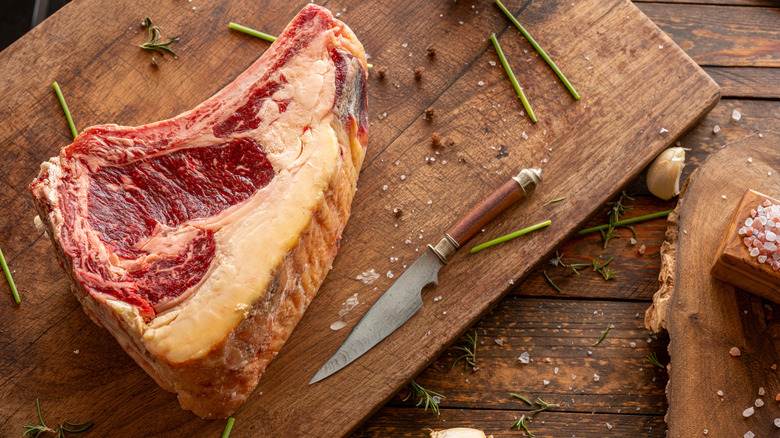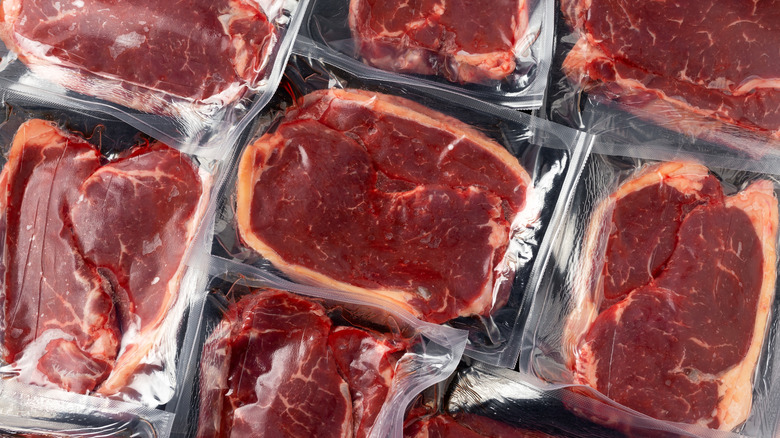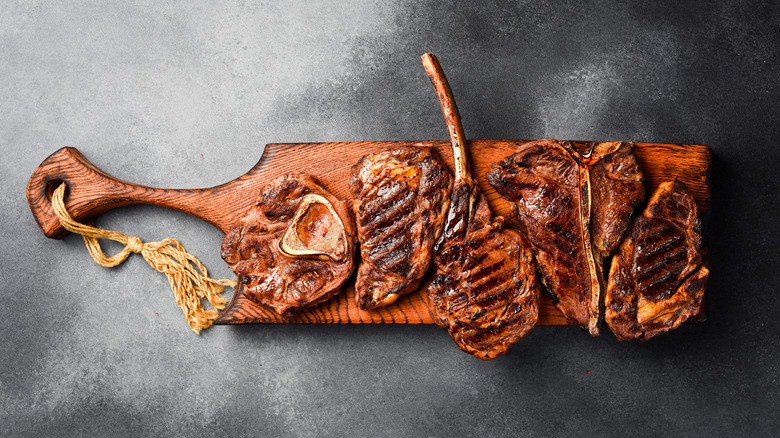Wet Vs Dry Aging Steaks: What's The Difference?
There seem to be a million and one different ways to prepare steak — whether you're sous vide-ing it, flame-grilling it, marinating it, or making it into a classic steak tartare. But that diversity doesn't just start with how you cook it — it starts long before you even buy it! Aging is a wonderful way to enhance your steak before it goes anywhere near your kitchen. The process harnesses science, allowing the enzymes naturally found in beef to slowly break down the tougher parts of the steak, releasing more flavor and improving its texture.
There are two main aging methods — dry and wet. They're both excellent ways to upgrade your beef, but what's the difference between them? It all comes down to the amount of moisture that's lost (or retained) during the aging process. You're likely familiar with dry aging. In this method, the beef is aged in open air inside a room (or fridge) kept at an extremely low temperature to prevent the growth of bacteria or other harmful microbes. Aging the beef in air allows the enzymes to tenderize it while it slowly dehydrates, which in turn concentrates the flavor.
Wet aging, on the other hand, is a relatively modern technique. It involves vacuum-sealing the steak and allowing it to age without any exposure to air. This method retains all of the steak's moisture while enhancing the enzymes' effects, resulting in super tender beef.
Why wet and dry-aged steaks taste different
Though both methods effectively tenderize steaks, wet and dry aging produce very different flavors. The flavor of a dry-aged steak is truly something special. Because the process removes a significant amount of moisture, the beef's flavor becomes concentrated, resulting in a deeply savory, almost nutty steak packed with umami. It's also considerably richer in flavor than its wet-aged counterpart. Thanks to partial dehydration, much of the fat in the cut is absorbed back into the meat, infusing it with a distinctly buttery richness. This is part of what makes dry-aged steak such a luxurious experience. Unless a menu (or your butcher) specifies that the meat is dry-aged, assume it has been wet-aged — most steaks are. The relative rarity of dry aging adds to its allure.
Wet aging, in contrast, preserves the beef's juices, and repurposes them to tenderize the steak while keeping it moist. Because there's no moisture loss, wet-aged steaks remain plump, but their flavor doesn't concentrate as it does in dry-aged steaks. As a result, wet-aged steaks have a more delicate, fresher taste that can sometimes even be subtly sweet.
How to prepare wet and dry-aged steaks
You might think that how your steak is aged shouldn't affect how you cook it — a steak is a steak, right? Well, no. In fact, the aging process impacts not only the steak's natural flavor, but also how it responds to different methods of preparation.
When cooking dry-aged steak, the goal is to highlight its deep, robust beefy flavor. To achieve this, you don't need elaborate sauces or fancy techniques. Simply cook it quickly over high heat and hit it with generous lashings of high-quality salt. There are many different types of salt you can reach for. Finishing salt is great for some extra texture and a more complex saltiness, but when it comes to seasoning a raw steak, coarse kosher salt is indisputably your best bet. The salt will draw out every facet of the beef's natural complexity, creating a truly delicious result.
Wet-aged steaks, on the other hand, give you a little more leeway when preparing them. Because they lack the intensity or depth of flavor that dry-aged steaks have, they're much better suited to a larger range of preparation techniques and pair wonderfully with sauces. You can grill them, sear them, smoke them, or even cook them Peter Luger-style in a super-heated oven (with a decadent butter sauce, no less). However you choose to prepare your steaks, make sure you know how to choose the perfect steak at the store from a supplier you trust, and you can't go wrong!



